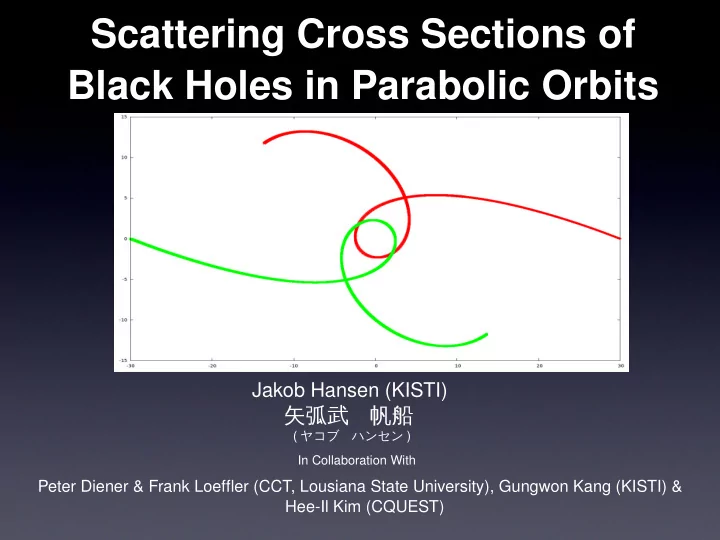

Scattering Cross Sections of Black Holes in Parabolic Orbits Jakob Hansen (KISTI) 矢弧武 帆船 ヤコブ ハンセン ) ( In Collaboration With Peter Diener & Frank Loeffler (CCT, Lousiana State University), Gungwon Kang (KISTI) & Hee-Il Kim (CQUEST)
Motivation(s) The study of scattering processes of two black holes is of interest for various reasons. For instance, the estimation of the cross sections with varying impact parameters is very important for understanding the evolution of black holes in galactic centers, in particular, the formation of super-massive black holes. Our Goals A) To study black holes moving in parabolic / weakly hyperbolic orbits, calculating capturing cross sections for such encounters B) To use KISTI supercomputers to do binary black hole simulations C) To gain experience in doing binary black hole simulations
Effective potential The radial equation of motion for a test particle can be written as :
Gravitational Capture for a massive particle For a given energy at infinity, E ∞ we can find a critical angular momentum value L crit that satisfies : E rad (L crit ) = E ∞ -1 Any black hole configuration with and will radiate more energy and will thus be captured.
Impact Parameter and Cross Section for a test particle The radial equation of motion for a test particle : At large distances, we find that : The (specific) angular momentum at infinity can be expressed as : Hence, we can write the impact parameter and cross section as :
Gravitational Capture for a massive particle We can then write the critical impact parameter as : And thus the energy dependent radiation capture cross section as :
L crit ( ̃ ̃ E ∞ ) How to find Option 1 ) For a given E ∞ , we may do a series of simulation to find L crit (E ∞ ), measure E rad for each simulation and compare with E ∞ to find L crit (E ∞ ). We do this for many E ∞ until we have covered parameter space to our satisfaction. Orbit with energy : E ∞ = E 1 E rad (L crit ) = E ∞ -1 L crit =L crit (E ∞ ) E rad =E ∞ -1 L=L crit
L crit ( ̃ ̃ E ∞ ) How to find Option 2 ) If v ∞ << 1, a hyperbolic orbit near periastron is almost indistinguishable from a parabolic orbit. This means that amount of emitted gravitational radiation is almost same. Thus we may make the assumption that the radiation emitted in a parabolic orbit is practically the same amount of radiation emitted in in a weakly hyperbolic orbit. I.e. we assume that E rad (E ∞ =1) ~ E rad (E ∞ =1 + ε ), ε <<1. E E ∞ =1+E rad (L) E rad (L crit ) = E ∞ -1 E ∞ =1 L crit (E ∞ ) E ∞ =1-E rad (L)
Numerical Setup ● We use the so-called Einstein Toolkit (based on the Carpet/Cactus code) to do our simulations. This is a free, open-source code which has been developed by hundreds of numerical relativists over the last 10 years. Try it, it’s free : http://einsteintoolkit.org ● We do our simulations of KISTI supercomputer: Tachyon2 ● Typical simulations use 256 cores and runs for about 3 days
Weyl 4 Scalar (from gr-qc://0707.4654)
Almost half of radiated energy is emitted in modes higher than l=2 mode! l=32 l=6 l=5 l=4 l=3 l=2
Main Computational challenges of doing high-accuracy parabolic BH-BH simulations ● Grid resolution: To achieve maximum accuracy, we need high numerical resolution ● Junk radiation: Junk radiation will disturb our results and thus should be minimized. This can be achieved by having large initial separation. ● Detection radius: Because of large separation between BH after meeting, we need to extract gravitational waves at high radii and/or extrapolate results. ● Limit on spherical harmonics: We use spherical harmonics decomposition to extract gravitational waves. However, because of non-circular orbits of BH, we need to extract waves at very high modes and/or extrapolate results.
Preliminary Results
Preliminary Results
Conclusions / Next steps : ● We have set up a numerical code to perform simulations of binary black holes in parabolic orbits / weakly hyperbolic orbits. ● We have tested convergence and extrapolation properties and believe we will be able to obtain results for calculating scattering cross sections of binary black holes in weakly hyperbolic orbits with high accuracy. ● We are in the process of doing simulations and analyzing data. ● Next we hope to investigate more advanced scenarios, e.g. with spin and non-equal mass ratios.
Thank you for your attention ご静聴 ありがとうございました
Recommend
More recommend